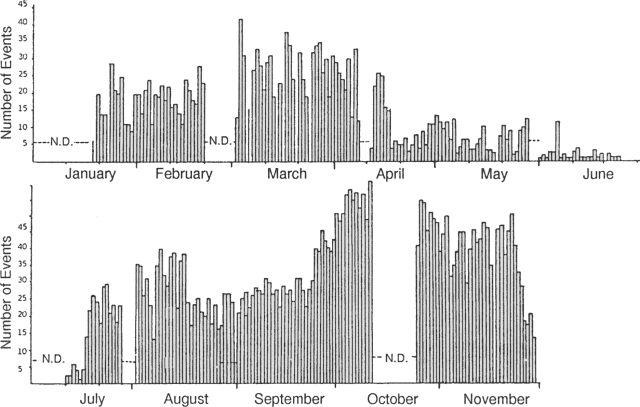Report on Arenal (Costa Rica) — November 1989
Scientific Event Alert Network Bulletin, vol. 14, no. 11 (November 1989)
Managing Editor: Lindsay McClelland.
Arenal (Costa Rica) Stronger seismicity; Strombolian explosions; lava flows
Please cite this report as:
Global Volcanism Program, 1989. Report on Arenal (Costa Rica) (McClelland, L., ed.). Scientific Event Alert Network Bulletin, 14:11. Smithsonian Institution. https://doi.org/10.5479/si.GVP.SEAN198911-345033
Arenal
Costa Rica
10.463°N, 84.703°W; summit elev. 1670 m
All times are local (unless otherwise noted)
During the first few months of 1989, activity at Arenal remained at its normal level. A small increase in Strombolian activity occurred in March, accompanied by as many as 42 volcanic events/day (figure 24), then declined rapidly, reaching a minimal rate in June with a mean of only 3/day. A renewed moderate increase in July was marked by stronger degassing associated with characteristic (blowing) sounds and more frequent tremor at a station (FOR, Red Sismológica Nacional) 4 km E of the crater. Activity built somewhat more during the first half of August, declining slightly before the onset of a stronger phase in late September. Daily seismicity reached its highest 1-day total, 64 shocks, on 11 October. Similar activity continued in November, with a mean of 40 earthquakes daily and a maximum of 52 (on the 21st), accompanied by significant tremor throughout the month.
November field observations revealed small to moderate Strombolian explosions, most of which ejected ash columns to 1-1.5 km height. Winds carried most of the ash to the W, where it fell on Lake Arenal (extending from the W foot of the volcano), and on some occasions reached Tilarán (~30 km away). Block lava from the upper crater (Crater C, at 1,300 m elevation) moved down the NW and SW flanks, with blocks spalled from flow fronts reaching elevations as low as 750 m elevation in the Río Tabacón area. Geologists noted that a similar level of activity had not occurred since 1984.
Geological Summary. Conical Volcán Arenal is the youngest stratovolcano in Costa Rica and one of its most active. The 1670-m-high andesitic volcano towers above the eastern shores of Lake Arenal, which has been enlarged by a hydroelectric project. Arenal lies along a volcanic chain that has migrated to the NW from the late-Pleistocene Los Perdidos lava domes through the Pleistocene-to-Holocene Chato volcano, which contains a 500-m-wide, lake-filled summit crater. The earliest known eruptions of Arenal took place about 7000 years ago, and it was active concurrently with Cerro Chato until the activity of Chato ended about 3500 years ago. Growth of Arenal has been characterized by periodic major explosive eruptions at several-hundred-year intervals and periods of lava effusion that armor the cone. An eruptive period that began with a major explosive eruption in 1968 ended in December 2010; continuous explosive activity accompanied by slow lava effusion and the occasional emission of pyroclastic flows characterized the eruption from vents at the summit and on the upper western flank.
Information Contacts: R. Barquero, ICE; G. Soto, Univ de Costa Rica.


